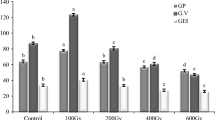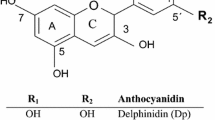Abstract
Photosynthesis is an important process for plants in which plants utilize the energy from sunlight to manufacture and produce all their own food. Although UV-C damage is not physiologically relevant for plants growing in the sun, short-wavelength (UV-C) radiation from germicidal lamps has been used to study cell damage in animals as well as in plants. This study provides a review of the effects of a methanolic extract of spinach (SE) as a natural powerful antioxidants used at two concentrations (25 and 50 ppm) on fenugreek seedlings grown under UV-C stress conditions. The results revealed that exposure of fenugreek seedlings to low UV-C period (30 min) increased growth criteria of the produced seedlings. In addition, the contents of chlorophyll, total pigments, total protein, free amino acids, non-enzymatic (carotenoids, total phenol, flavonoids, α‑tocopherol & ascorbic acid contents) and enzymatic antioxidants were increased at this period. By increasing exposure periods of UV-C radiation, the growth criteria and chemical constitutes of the seedlings were decreased. Application of lower concentration of SE (25 ppm) improve the growth of the seedlings at 30-min UV-C and was able to protect seedlings from high periods of UV-C irradiation by increasing all measured parameters except CAT. These increases might be an adaptive mechanism to minimize the adverse effects of longer exposure of UV-C radiation. Moreover, treating the irradiated seedlings with spinach extract led to an obvious alteration in gene expression including synthesis of some proteins bands and disappearance of other protein sets of the protein profile.
Zusammenfassung
Die Photosynthese ist ein wichtiger Prozess für Pflanzen, bei dem sie die Sonnenenergie zum Aufbau und zur Erzeugung ihrer lebensnotwendigen Stoffe benutzen. Obwohl die UV-C-Schäden physiologisch für die in der Sonne gewachsenen Pflanzen nicht relevant sind, wurde die Kurzwellenradiation (UV-C) aus Ultraviolett-Lampen verwendet, um Zellenschäden bei Tieren und Pflanzen zu untersuchen.
Diese Studie setzt sich mit den Resultaten über die Wirkung des Spinatextraktes (SE) als natürliches, starke Antioxidationsmittel in zwei Konzentrationen (25 und 50 ppm) auf die Bockhornkleesprossen, die unter belastenden UV-C-Bestrahlungen aufgewachsen sind, auseinander. Die Ergebnisse zeigen, dass die Bestrahlung der Bockhornkleesprosse mit UV-C für eine kurze Zeitdauer (30 min) die Wachstumsmerkmale der produzierten Sprosse erweitert. Außerdem erhöht sich der Gehalt an Chlorophyll, Gesamtpigmenten, Gesamtprotein, freien Aminosäuren, nicht-enzymatischen (Karotinide, Gesamtphenole, Flavonoide, Alpha-Tocopherol und Ascorbicsäure) und enzymatischen Antioxidationsmitteln in dieser Periode. Bei einer Verlängerung der Bestrahlungszeit mit UV-C verringern sich die Wachstumsmerkmale und die chemischen Bestandteile der Sprosse. Die Verwendung der niedrigen SE-Konzentration (25 ppm) verbessert die Wachstumsmerkmale der Sprosse bei 30-Minuten-UV-C-Bestrahlung und schützt die Sprosse vor langen Perioden der UV-C-Irradiation. Das zeigt sich an der Steigerung aller Messparameter außer CAT. Diese Steigerung könnte ein Kompensationsmechanismus zur Reduzierung der schlechten Einflüsse der langen UV-C-Radiation sein. Außerdem führt die Behandlung der bestrahlten Sprosse mit dem Spinatextrakt zu einer klaren Veränderung in der Genexpression: zum einen in der Synthese sowie sowie im Verschwinden Proteingruppen in dem Proteinprofil.



Similar content being viewed by others
References
Abd El-hamid EM, Sadak MS, Tawfik MM (2016) Physiological response of Fenugreek plant to the application of proline under different water regimes. Res J Pharm Biol Chem Sci 7:580–594
Al-Dosari MS (2010) Antioxidant and protective effects of spinach (Spinacia oleracea L.) leaves against carbon tetrachloride induced liver injury. Int J Clin Exp Med 4:129–140
Athar H, Ashraf M, Jamal AA (2009) Inducing salt tolerance in canola (Brassica napus L.) by exogenous application of glycinebetaine and proline: response in the initial growth stages. Pak J Bot 41:1311–1319
Balakrishnan V, Venkatesan K, Ravindran KC, Kulandaivelu G (2005) Protective mechanism in UV-B treated Crotalaria juncea L. seedlings. Plant Protect Sci 41:115–120
Bergman M, Varshavsky L, Gottlieb HE, Grossman S (2001) The antioxidant activity of aqueous spinach extract: chemical identification of active fractions. Phytochem 58:143–152
Bergmeyer HU (1974) Methods of Enzymatic Analysis 1, 2nd edn. Academic Press, New York
Bhatia AL, Jain M (2004) Spinacia oleracea L. protects against gamma radiations: a study on glutathione and lipid peroxidation in mouse liver. Phytomedicine 11:607–615
Booij-James IS, Dube SK, Jansen MAK, Edelman M, Mattoo AK (2000) Ultraviolet-B radiation impacts lightmediated turnover of the photosystem II reaction center heterodimer in arabidopsis mutants altered in phenolic metabolism. Plant Physiol 124:1275–1283
De Britto JA, Jeevitha M, Stephan L, Raj T (2011) Alterations of protein and DNA profiles of Zea mays L. under UV- B radiation. J Stress Physiol Biochem 7:232–240
Bunea A, Andjelkovic M, Socaciu C, Bobis O, Neacsu M, Verhe R et al (2008) Total and individual carotenoids and phenolic acids content in fresh, refrigerated and processed spinach (Spinacia oleracea L.). Food Chem 108:649–656
Bushra S, Farooq A, Muhammad A (2009) Effect of extraction solvent/technique on the antioxidant activity of selected medicinal plant extracts. Molecules 14:2167–2180
Charles MT, Tano K, Asselin A, Arul J (2009) Physiological basis of UV-C induced resistance to Botrytis cinerea in tomato fruit V. Constitutive defence enzymes and inducible pathogenesis related proteins. Postharvest Biol Technol 51:414–424
Chatterjee S, Variyar PS, Sharma A (2010) Bioactive lipid constituents of fenugreek. Food Chem 1:349–353
Chen Y, Cao XD, Lu Y, Wang XR (2000) Effects of rare earth metal ions and their EDTA complexes on antioxidant enzymes of fish liver. Bull Environ Contam Toxicol 65:357–365
Chun OK, Kim DO, Lee CY (2003) Superoxide radical scavenging activity of the major polyphenols in fresh plums. J Agric Food Chem 51:8067–8072
Flint SD, Ryel RJ, Caldwell MM (2003) Ecosystem UV-B experiments in terrestrial communities: a review of recent findings and methodologies. Agric For Meteorol 120:177–189
Fornaciari S, Milano F, Mussi F, Pinto-Sanchez L, Forti L, Buschinib A, Arru L (2015) Assessment of antioxidant and antiproliferative properties of spinach plants grown under low oxygen availability. J Sci Food Agric 95:490–496
González-Aguilar GA, Zavaleta-Gatica R, Tiznado-Hernández ME (2007) Improving postharvest quality of mango ‘Haden’ by UV-C treatment. Postharvest Biol Technol 45:108–116
Gorelick-Feldman J, Maclean D, Ilic N, Poulev A, Lila MA, Cheng D et al (2008) Phytoecdysteroids increase protein synthesis in skeletal muscle cells. J Agric Food Chem 56:3532–3537
Gout E, Boisson AM, Aubert S, Douce R, Bligny R (2001) Origin of the cytoplasmic pH changes during anaerobic stress in higher plant cells. Carbon-13 and phosphorus-31 nuclear magnetic resonance studies. Plant Physiol 125:912–925
Jain K, Kataria S, Guruprasad KN (2004) Effect of UV-B radiation on antioxidant enzymes and its modulation by benzoquinone and α‑tocopherol in cucumber cotyledons. Curr Sci 87:87–90
Kar M, Mishra D (1976) Catalase, peroxidase and polyphenol oxidase activities during rice leaf senescence. Plant Physiol 57:315
Kobashigawa C, Tamaya K, Shimomachi T (2011) Effect of UV-C treatment on plant growth and nutrient contents. Acta Hortic 907:237–242
Laememli UK (1970) Cleavage of structure proteins during the assembly of the head of bacteriophage T4. Nature 227:680–685
Lamhamdi M, Bakrim A, Bouayad N, Aarab A, Lafont R (2013) Protective role of a methanolic extract of spinach (Spinacia oleracea L.) against Pb toxicity in wheat (Triticum aestivum L.) seedlings: beneficial effects for a plant of a nutraceutical used with animals. Environ Sci Pollut Res 20:7377–7385
Liu W, Yang Q (2012) Effects of supplemental UV-A and UV-C irradiation on growth, photosynthetic pigments and nutritional quality of pea seedlings. Acta Hortic 956:657–663
Lomnitski L, Padilla-Banks E, Jefferson WN, Nyska A, Grossman S, Newbold RR (2003) A natural antioxidant mixture from spinach does not have estrogenic or antiestrogenic activity in immature CD-1 mice. J Nutr 3:3584–3587
Lowry OH, Rosembrough NJ, Farr AL, Randall RJ (1951) Protein measurement with the folin phenol reagent. J Biol Chem 193:267–275
Maeda N, Yoshida H, Mizushina Y (2010) Spinach and health: anticancer effect. In: Watson RR, Preedy VR (eds) Bioactive foods in promoting health: fruit and vegetables. Elsevier, Amsterdam, pp 393–405
Mahdavian K, Ghorbanli M, Kalantari KM (2008) The effects of ultraviolet radiation on the contents of chlorophyll, flavonoid, anthocyanin and proline in Capsicum annuum L. Turk J Bo 32:25–33
Martino CD, Delfine S, Pizzuto R, Loreto F, Fuggi A (2003) Free amino acids and glycine betaine in leaf osmoregulation of spinach responding to increasing salt stress. New Phytol 158:455–463
Montgomery J (2009) The potential of fenugreek (Trigonella foenum-graecum) as a forage for dairy herds in central Alberta. University of Alberta, USA, pp 4–15
Moore S, Stein WH (1954) A modified ninhydrin reagent for the photometric determination of amino acids and related compounds. J Biol Chem 211:907–913
MuKherjee SP, Choudhuri MA (1983) Implication of water stress-induced changes in the levels of endogenous ascorbic acid and hydrogen peroxide in Vigna seedling. Plant Physiol 58:166–170
Nasibi F, Kalantari KM (2005) The effects of UV-A, UV-B and UV-C on protein and ascorbate content, lipid peroxidation and biosynthesis of screening compounds in Brassica napus. Iran J Sci Technol 29:39–48
Neelamegam R, Sutha T (2015) UV-C irradiation effect on seed germination, seedling growth and productivity of groundnut (Arachis hypogaea L.). Int J Curr Microbiol App Sci 4:430–443
Otari KV, Gaikwad PS, Shete RV (2010) Spinach olerracea Linn: a pharmacognostic and pharmacological overview. Int J Res Ayurveda Pharm 1:78–84
Palma JM, Sandalio LM, Corpas FJ, Romero-puertas MCM, Del Rio LA (2002) Plant proteases, protein degradation and oxidative stress: role of peroxisoms. Plant Physiol Biochem 40:521–530
Perry A, Rasmussen H, Johnson EJ (2009) Xanthophyll (lutein, zeaxanthin) content in fruits, vegetables and corn and egg products. J Food Compost Anal 22:9–15
Philip B, Bernard L, William H (1954) Vitamins and deficiency diseases. In: Practical physiological chemistry. McGraw-Hill, New York, Toronto, London, pp 1272–1274
Posé D, Castanedo I, Borsani O, Nieto B, Rosado A, Taconnat L, Ferrer A, Dolan L, Valpuesta V, Botella MA (2009) Identification of the arabidopsis dry2/sqe1-5 mutant reveals a central role for sterols in drought tolerance and regulation of reactive oxygen species. Plant J 59:63–76
Rahimzadeh P, Hosseini S, Dilmaghani K (2011) Effects of UV-A and UV-C radiation on some morphological and physiological parameters in Savory (Satureja hortensis L.). Ann Biol Res 2:164–171
Ramya S, Balakrishnan V (2013) Impacts of ultraviolet-B radiation on Antioxidant defense system in Aeschynomene aspera L. Res Plant Biol 3:37–42
Rastogi RP, Singh SP, Incharoensakdi A, Häder DP, Sinha RP (2014) Ultraviolet radiation-induced generation of reactive oxygen species, DNA damage and induction of UV-absorbing compounds in the cyanobacterium Rivularia sp. HKAR-4. S Afr J Bot 90:163–169
Rathore D, Agrawal SB, Singh A (2003) Influence of supplemental UV-B radiation and mineral nutrients on biomass, pigments and yield of two cultivars of wheat. Int J Biotronics 32:1–15
Sadak MSh (2016) Mitigation of drought stress on fenugreek plant by foliar application of trehalose. Inter J Chem Tech Res 9:147–155
Sajid M, Khan MA, Bilal W, Rab A, Iqbal Z, Khan SI (2017) Anti-oxidant activities, chemical attributes and fruit yield of peach cultivars as influenced by foliar application of ascorbic acid. Gesund Pflanzen 69(3):113–121. https://doi.org/10.1007/s10343-017-0395-7
Shahidi F, Naczk M (1995) Methods of analysis and quantification of phenolic compounds. Food phenolic: sources, chemistry, effects and applications. Technomic Publishind Company, Inc, Lancaster, pp 287–293
Vernon LP, Seely GR (1966) The chlorophylls. Academic Press, New York
Zhang J, Cui S, Li J, Wei J, Kirkham MB (1995) Protoplasmic factors, antioxidant responses, and chilling resistance in maize. Plant Physiol Biochem 33:567–575
Author information
Authors and Affiliations
Corresponding author
Ethics declarations
Conflict of interest
A.H.M.A. Mohammed and S.A. Akladious declare that they have no competing interests.
Rights and permissions
About this article
Cite this article
Mohammed, A.H.M.A., Akladious, S.A. Protective Role of a methanolic Extract of Spinach (Spinacia oleracea L.) Against Adverse Effects of UV-C Irradiation on Fenugreek (Trigonella foenum-graecum L.) Seedlings. Gesunde Pflanzen 69, 185–196 (2017). https://doi.org/10.1007/s10343-017-0404-x
Received:
Accepted:
Published:
Issue Date:
DOI: https://doi.org/10.1007/s10343-017-0404-x
Keywords
- Spinach extract
- UV-C irradiation
- Antioxidant activity
- Fenugreek seedlings-Enzymatic & non-enzymatic mechanisms




